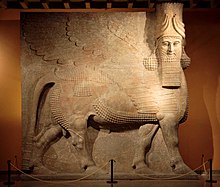Lamassu

En lamassu (flertal lumasi) (Sumerisk: dlammař; akkadisk: lamassu; nogle gange kaldet lamassus[1][2]) er en assyrisk beskyttende guddom, der ofte er afbildet med et menneskehoved, en krop fra en tyr eller en løve og fuglevinger.[3] I nogle skriftlige kilder bliver den beskrevet som at repræsentere en kvindelig guddom.[4][5] Et mindre anvendt navn er shedu, som refererer til det mandlige modstykke til en lamassu.[6] Lammasu eller lumasi repræsenterer dyrekredse, forældrestjerner eller stjernebillede.[7][8]
Store lamassufigurer var op mod 6 meter høje, og er en vigtig del af assyrisk skulpturkunst, hvor de er de største figurer, som man kender til.
Referencer
- ^ Kriwaczek, Paul. Babylon: Mesopotamia and the Birth of Civilization, p. 37.
- ^ "Arkiveret kopi". Arkiveret fra originalen 8. marts 2016. Hentet 14. november 2017.
- ^ "Livius.org". Arkiveret fra originalen 9. februar 2010. Hentet 14. november 2017.
- ^ Beaulieu, Paul-Alain. The Pantheon of Uruk during the Neo-Babylonian Period. Hentet 9. december 2010.
- ^ "The Pennsylvania Sumerian Dictionary". Hentet 9. december 2010.
- ^ Black, Jeremy; Green, Anthony (2003). An Illustrated dictionary, Gods, Demons and Symbols of Ancient Mesopotamia. The British Museum Press. ISBN 0-7141-1705-6.
- ^ Hewitt, J.F. History and Chronology of the Myth-Making Age. s. 85.
- ^ W. King, Leonard. Enuma Elish Vol 1 & 2: The Seven Tablets of Creation; The Babylonian and Assyrian Legends Concerning the Creation of the World and of Mankind. s. 78.
Medier brugt på denne side
Forfatter/Opretter: unknown, Licens: CC BY-SA 3.0
This is the Assyrian Lamassu at the Oriental Institute Museum at the University of Chicago.
Gypsum (?) Khorsabad, entrance to the throne room Neo-Assyrian Period, ca. 721-705 B.C. OIM A7369
This 40 ton statue was one of a two flanking the entrance to the throne room of King Sargon II. A protective spirit known as a lamassu, it is shown as a composite being with he head of a human, the body and ears of a bull, and the wings of a bird. When viewed from the side, the creature appears to be walking; when viewed from the front, to be standing still. Thus it is actually represented with five, rather than four legs.
Being approximately 2700 years old, copyright does not apply to this statue.